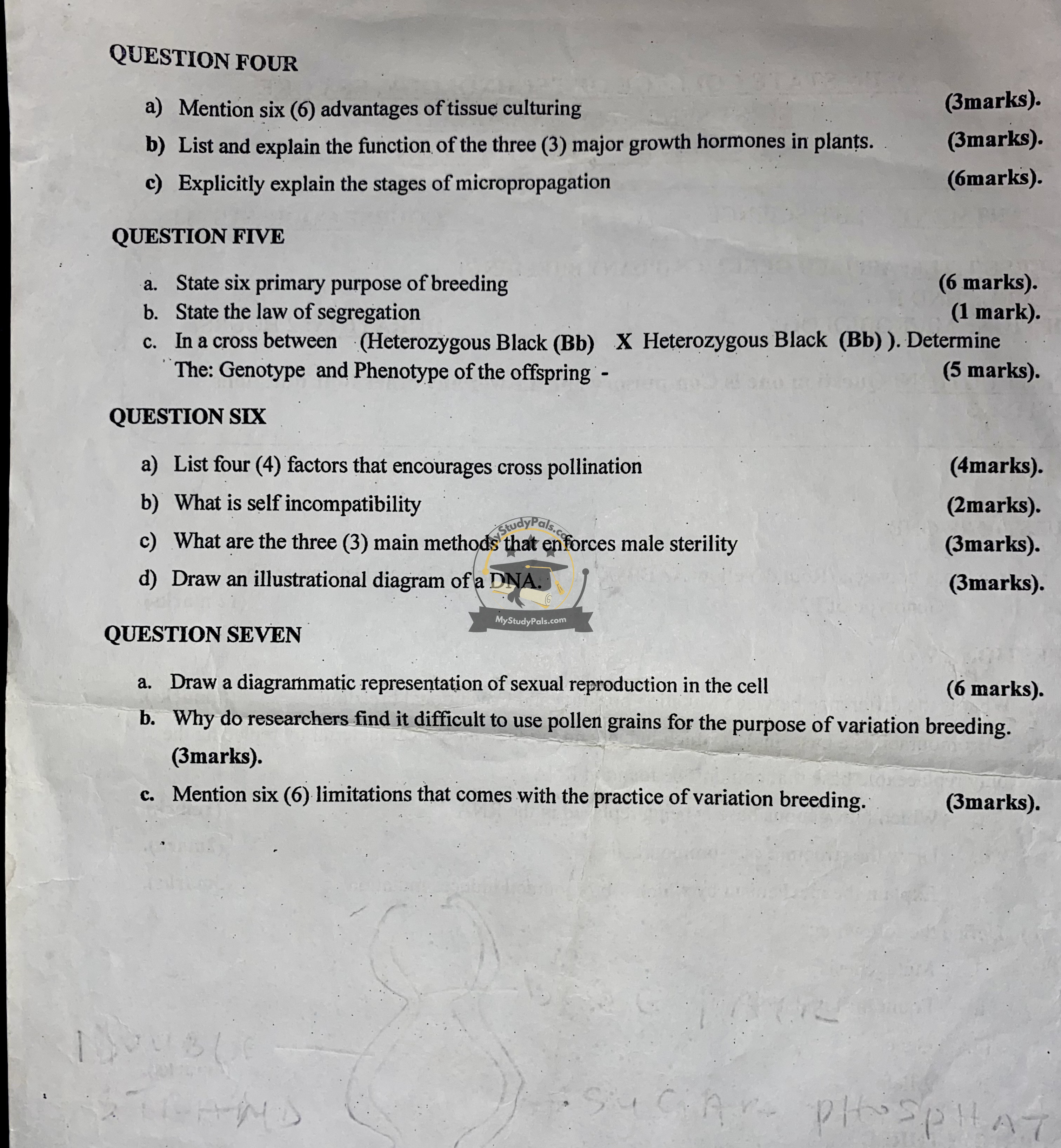ANWSER
Question One
a. In a cross between (Round Yellow AABB × aabb Wrinkled Green), determine the genotype of F2.
Answer:
- Parental cross: AABB × aabb
- F1 generation: AaBb (All heterozygous round yellow)
- F2 generation: The F1 hybrid (AaBb) undergoes self-crossing: AaBb × AaBb.
- Using the dihybrid cross, we apply the Mendelian ratio 9:3:3:1.
- F2 phenotypic ratio:
- 9/16 Round Yellow (A_B_)
- 3/16 Round Green (A_bb)
- 3/16 Wrinkled Yellow (aaB_)
- 1/16 Wrinkled Green (aabb)
- F2 genotypes:
- 1 AABB
- 2 AABb
- 2 AaBB
- 4 AaBb
- 1 AAbb
- 2 Aabb
- 1 aaBB
- 2 aaBb
- 1 aabb
Question Two
a. Difference between mutation breeding and conventional breeding.
Answer:
- Mutation breeding: Involves exposing seeds or plants to chemicals or radiation to induce genetic mutations that may be beneficial.
- Conventional breeding: Involves selective breeding by crossing plants with desirable traits to obtain improved varieties naturally.
b. 5-Bromouracil Mutation Mechanism
i. Which nitrogenous base is replaced in RNA?
- Answer: Uracil (U) is replaced by 5-Bromouracil (5-BU), which behaves like thymine (T) in DNA.
ii. Structure of 5-Bromouracil:
- (You need to draw the molecular structure of 5-BU.)
iii. Mechanism of mutation induction by 5-Bromouracil
- Answer:
- 5-BU is a thymine analog and can pair with adenine (A).
- During DNA replication, it may undergo tautomeric shifts and mispair with guanine (G) instead of adenine (A).
- This leads to transition mutations (T-A to C-G substitutions).
c. Definitions
i. Mutagenesis: The process by which genetic mutations are induced artificially or naturally.
ii. Frameshift mutation: A mutation caused by insertions or deletions of nucleotides in the DNA sequence, shifting the reading frame.
iii. Gene: A hereditary unit that codes for a protein and determines traits.
iv. Allele: Different forms of a gene found at the same locus on homologous chromosomes.
Question Three
a. Define crop breeding.
Answer:
- Crop breeding is the science of modifying plant genetics to develop new varieties with improved characteristics such as higher yield, disease resistance, and better adaptation to environmental conditions.
b. Compare and contrast qualitative and quantitative inheritance.
| Feature | Qualitative Inheritance | Quantitative Inheritance |
|---|---|---|
| Trait Type | Discrete (e.g., color, shape) | Continuous (e.g., height, weight) |
| Number of Genes | Controlled by one or few genes | Controlled by many genes (polygenic) |
| Influence of Environment | Minimal | High |
| Segregation Pattern | Mendelian ratios (3:1, 9:3:3:1) | No clear Mendelian ratios |
| Example | Flower color, seed shape | Plant height, grain yield |
Question Four
a. Mention six advantages of tissue culturing.
Answer:
- Rapid propagation of plants.
- Disease-free plants can be produced.
- Conservation of rare or endangered plant species.
- Genetic uniformity among plants.
- Year-round production independent of seasons.
- Mass production of high-quality seedlings.
b. List and explain the function of three major growth hormones in plants.
Answer:
- Auxins: Promote stem elongation, root growth, and fruit development.
- Gibberellins: Stimulate seed germination, stem elongation, and flowering.
- Cytokinins: Encourage cell division, shoot growth, and delay aging.
c. Stages of micropropagation
- Initiation: Selection and sterilization of explants.
- Multiplication: Cell division and shoot proliferation in culture.
- Rooting: Development of roots in plantlets.
- Acclimatization: Hardening and transferring plants to soil.
Question Five
a. State six primary purposes of breeding.
- To increase crop yield.
- To improve resistance to diseases and pests.
- To enhance environmental adaptability.
- To improve crop quality (taste, size, shelf-life).
- To shorten growth duration.
- To develop hybrid vigor.
b. State the law of segregation.
- Answer: The law of segregation states that each organism carries two alleles for each trait, which separate during gamete formation, ensuring each gamete gets only one allele.
c. Cross between Heterozygous Black (Bb) × Heterozygous Black (Bb)
- F2 Genotype: BB, Bb, Bb, bb (1:2:1)
- F2 Phenotype: 3 Black : 1 White
Question Six
a. List four factors that encourage cross-pollination.
- Wind
- Insects (bees, butterflies)
- Water (in aquatic plants)
- Structural adaptations (dioecy, heterostyly)
b. What is self-incompatibility?
- Answer: A genetic mechanism in plants that prevents self-fertilization, ensuring genetic diversity.
c. Three methods that enforce male sterility.
- Genetic male sterility (controlled by nuclear genes).
- Cytoplasmic male sterility (CMS) (inherited maternally).
- Chemical hybridizing agents (induce sterility chemically).
d. Draw a DNA diagram.
- (You need to draw the double helix structure of DNA.)
Question Seven
a. Draw a diagrammatic representation of sexual reproduction in the cell.
- (You need to draw meiosis, showing chromosome division.)
b. Why do researchers find it difficult to use pollen grains for variation breeding?
- Answer:
- Pollen grains have limited genetic material.
- They do not contain cytoplasmic genes.
- Pollen storage and viability are challenging.
- Unstable environmental factors affect pollen activity.
c. Mention six limitations of variation breeding.
- Mutations may be harmful.
- Some mutations are recessive and may not be expressed.
- Time-consuming process.
- Environmental factors affect gene expression.
- Low success rate of desirable traits.
- Expensive to conduct and maintain.



